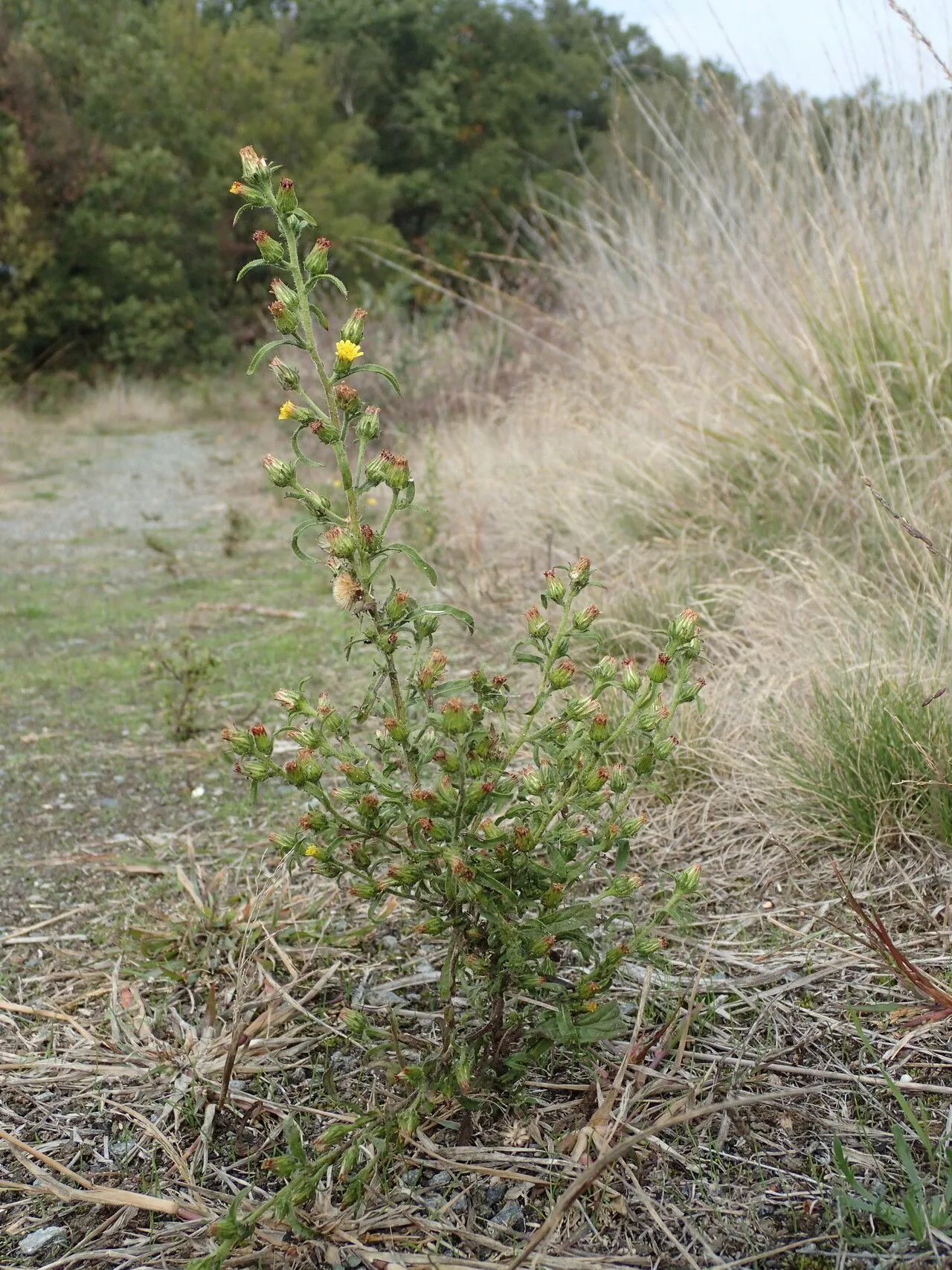
Author: (L.) Greuter
Bibliography: Exsicc. Genav. Conserv. Bot. Distrib. Fasc. 4: 71 (1973)
Year: 1973
Status: accepted
Rank: species
Genus: Dittrichia
Vegetable: False
Observations: Medit. to W. Himalaya
Camphor inula (Dittrichia graveolens)
Camphor inula, scientifically known as Dittrichia graveolens, is a notable member of the Asteraceae family. Originally documented in “Exsicc. Genav. Conserv. Bot. Distrib. Fasc. 4: 71” in 1973 by (L.) Greuter, this plant has captured the interest of botanists and nature enthusiasts alike with its unique characteristics and widespread presence.
This resilient herbaceous plant has a remarkable range, thriving from the Mediterranean region to the Western Himalayas. Dittrichia graveolens is particularly distinctive for its strong aromatic scent, which is reminiscent of camphor, a feature that has inspired its common name, Camphor inula. The plant’s scent is due to the presence of essential oils, which have been historically appreciated for their potential therapeutic properties.
Ecologically, Camphor inula contributes to its environment by flourishing in a variety of habitats, from disturbed grounds to roadsides, showcasing its adaptability to different soil types and climatic conditions. Its robust nature allows it to colonize new areas effectively, which can be both beneficial in stabilizing soils and challenging when it becomes overly dominant in certain ecosystems.
Visually, the plant is characterized by its erect, branching stems, covered in fine hairs, and bearing yellow, daisy-like flowers that attract a plethora of pollinators. These features not only add to the biodiversity of the regions where it grows but also serve as an indicator of the health of local ecosystems.
In conclusion, Dittrichia graveolens, or Camphor inula, serves as a fascinating study for botanists due to its distinctive characteristics and extensive range. Whether appreciated for its aromatic properties, its adaptability, or its role in local ecosystems, this plant remains an integral part of the flora from the Mediterranean to the Western Himalayas.
Eng: cape khakiweed, stinking fleabane, stinkwort, camphor inula, stink aster, stinking-fleabane, stinkweed
Deu: duft-klebalant, klebriger alant, starkduftender alant, stinkender klebalant, drüsiger alant
Nld: kamferalant
Fra: inule fétide
Swe: kamferinula, kamferkrissla
Cym: cedowydd drewllyd
En: Camphor inula, Stinking-fleabane, Stinkweed, Stinkwort, Cape khakiweed, Stink aster, Stinking Fleabane
Af: Kaapse kakiebos
Ar: طباق نفاح
Ca: Olivardó
Co: Pecitella
Cs: Ditrichie smradlavá
Nl: Kamferalant
Fi: Pikkutahmakko
Fr: Inule fétide, Inule odorante, Inule à forte odeur
De: Drüsiger Alant, Klebriger Alant, Klebalant, Duft-Klebalant, Starkduftender Alant, Stinkender Klebalant, Einjähriger Klebalant
He: טיון חריף
It: Enula, Enula Céspita, Fulichi
Es: Olivardilla
Sv: Kamferinula, Kamferkrissla
Cy: Cedowydd drewllyd
Taken Oct 14, 2021 by Llandrich anna (cc-by-sa)
Taken Sep 23, 1993 by Tela Botanica − Liliane ROUBAUDI (cc-by-sa)
Taken Feb 2, 2020 by Christelle Martins (cc-by-sa)
Taken Oct 14, 2018 by Pascale Charvier (cc-by-sa)
Taken Oct 17, 2020 by Rico García Antonio (cc-by-sa)
Taken Oct 10, 2022 by Sylvain Piry (cc-by-sa)
Taken Oct 2, 2021 by Albert Mallol Camprubí (cc-by-sa)
Taken Jul 23, 2021 by Lazo Alfonso (cc-by-sa)
Taken Oct 15, 2016 by Tela Botanica − Patrick LEBOULENGER (cc-by-sa)
Taken Oct 10, 2022 by Sylvain Piry (cc-by-sa)
Taken Nov 12, 2022 by Kai Best (cc-by-sa)
Taken Oct 14, 2021 by Llandrich anna (cc-by-sa)
Taken Dec 4, 2016 by Tela Botanica − Patrick LEBOULENGER (cc-by-sa)
Taken Nov 13, 2016 by Tela Botanica − Patrick LEBOULENGER (cc-by-sa)
Taken Jan 24, 2019 by César Gonzalez (cc-by-sa)
Taken Nov 12, 2022 by Kai Best (cc-by-sa)
Taken Oct 14, 2021 by Llandrich anna (cc-by-sa)
Taken Aug 14, 2018 by Antonio Rey (cc-by-sa)
Taken Feb 2, 2022 by Giuseppe Marano (cc-by-sa)
Taken Oct 10, 2022 by Sylvain Piry (cc-by-sa)
Taken Oct 14, 2021 by Llandrich anna (cc-by-sa)
Taken Oct 20, 2022 by Luis Almeda (cc-by-sa)
Taken Oct 14, 2022 by Adrian Domínguez (cc-by-sa)
Taken Nov 12, 2022 by Kai Best (cc-by-sa)
Taken Oct 14, 2021 by Llandrich anna (cc-by-sa)
Taken Oct 12, 2019 by claudio (cc-by-sa)
Taken Dec 13, 2020 by Christophorus a Castalia (cc-by-sa)
Taken Feb 23, 2019 by Thierry girard (cc-by-sa)
Taken Aug 21, 2019 by lnu’skw (cc-by-sa)
Taken Oct 14, 2021 by Llandrich anna (cc-by-sa)
Taken Aug 14, 2018 by Antonio Rey (cc-by-sa)
Taken Oct 4, 2018 by odt (cc-by-sa)
Taken Aug 23, 2020 by Dabronzo Carlo (cc-by-sa)
Taken Jan 1, 1970 by Photoflora – L’Abbé COSTE (©)
Taken Oct 15, 2011 by Photoflora – Benoit BOCK (©)
Taken Sep 26, 1885 by Tela Botanica − Herbier PONTARLIER-MARICHAL (cc-by-sa)
Taken Jun 14, 2006 by Tela Botanica − Laurent PETIT (cc-by-sa)
Taken Sep 17, 2020 by raphaelh (cc-by-sa)
Taken Oct 27, 2010 by Tela Botanica − Pascal AMBLARD (cc-by-sa)
© copyright of the Board of Trustees of the Royal Botanic Gardens, Kew.
© copyright of the Board of Trustees of the Royal Botanic Gardens, Kew.
© copyright of the Board of Trustees of the Royal Botanic Gardens, Kew.
Growth habit: Forb/herb
Ph maximum: 8.0
Ph minimum: 7.5
Light: 8
Atmospheric humidity: 4
Bloom months: [‘aug’, ‘sep’, ‘oct’]
Soil nutriments: 6
Family: Myrtaceae Author: (F.Muell.) K.D.Hill & L.A.S.Johnson Bibliography: Telopea 6: 402 (1995) Year: 1995 Status:…
Family: Rubiaceae Author: Pierre ex A.Froehner Bibliography: Notizbl. Bot. Gart. Berlin-Dahlem 1: 237 (1897) Year:…
Family: Sapindaceae Author: Koidz. Bibliography: J. Coll. Sci. Imp. Univ. Tokyo 32(1): 38 (1911) Year:…
Family: Asteraceae Author: A.Gray Bibliography: Pacif. Railr. Rep.: 107 (1857) Year: 1857 Status: accepted Rank:…
Family: Fabaceae Author: Medik. Bibliography: Vorles. Churpfälz. Phys.-Ökon. Ges. 2: 398 (1787) Year: 1787 Status:…
Family: Aspleniaceae Author: (Cav.) Alston Bibliography: Bull. Misc. Inform. Kew 1932: 309 (1932) Year: 1932…